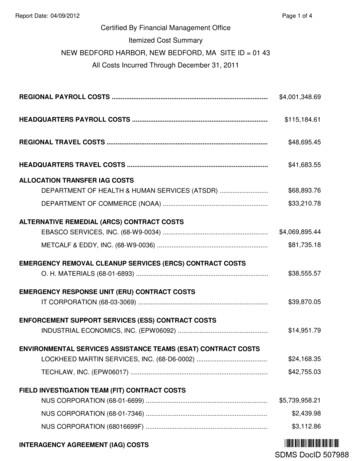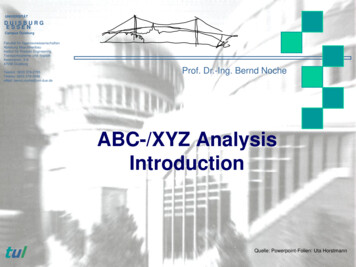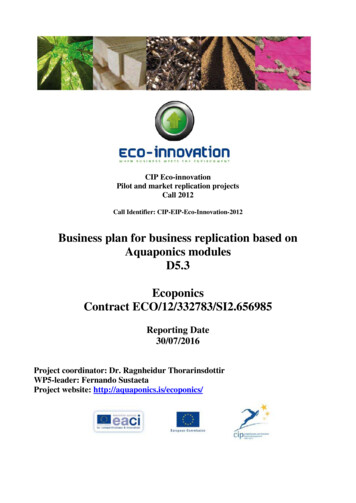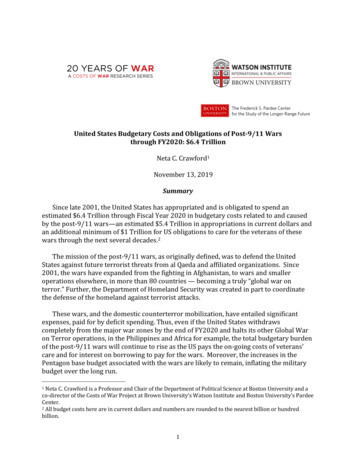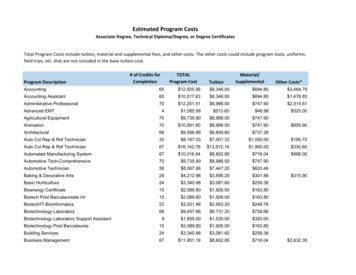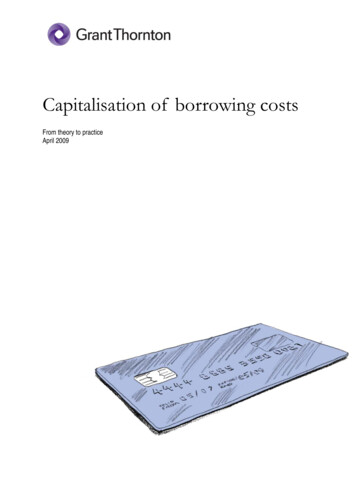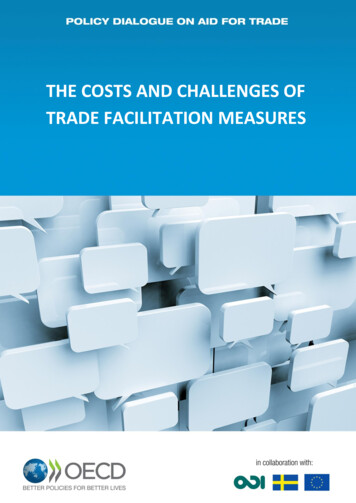
Transcription
THE COSTS AND CHALLENGES OFTRADE FACILITATION MEASURES
For Official UseTAD/TC/WP(2012)25Organisation de Coopération et de Développement ÉconomiquesOrganisation for Economic Co-operation and Development21-Nov-2012English - Or. EnglishTRADE AND AGRICULTURE DIRECTORATETRADE COMMITTEETAD/TC/WP(2012)25For Official UseWorking Party of the Trade CommitteeTHE COSTS AND CHALLENGES OF TRADE FACILITATION MEASURES4-5 December 2012The OECD Conference Centre, ParisThis paper presents a preliminary version of the work to update the 2005 study of the Trade Committee on thecosts of introducing and implementing trade facilitation measures, drawing on data that had been received by theSecretariat on 16th November 2012. Further information on the covered countries and data on additionalcountries are expected from the World Customs Organization (WCO) as soon as clearance has been providedfrom the concerned countries. This information will allow completing the paper and deepening the analysis.Action required: For discussionLink to the Programme of Work and budget: This work falls under Section 3.1.1.2.3 (Trade Facilitation) of the2011-2012 PWB.Cooperation: Data for the paper were collected by the WCO SecretariatContact: Evdokia Moïsé, Tel: 33 (0)1 45 24 89 09, Email: evdokia.moise@oecd.orgEnglish - Or. EnglishJT03331296Complete document available on OLIS in its original formatThis document and any map included herein are without prejudice to the status of or sovereignty over any territory, to the delimitation ofinternational frontiers and boundaries and to the name of any territory, city or area.
TAD/TC/WP(2012)25THE COSTS AND CHALLENGES OF TRADE FACILITATION MEASURESI.Introduction1.The costs of trade facilitation measures to developing country governments and administrations havebeen one of the central issues of the WTO negotiations on trade facilitation even before their launch.1 Inorder to inform the discussions and build confidence in the feasibility of the proposed measures fordeveloping countries, the Trade Committee undertook in 2005 to analyse the costs of introducing andimplementing trade facilitation measures, based on the experience of fifteen non-member countries2 thathad just introduced, or were in the process of introducing, trade facilitation measures and had figures ontheir implementation expenses. The aim of the study was to provide indications as to the relative costs andcomplexity of the measures, the challenges presented by their implementation, and approaches forovercoming such challenges in practice.2.The study, which was included in the OECD publication “Overcoming Border Bottlenecks, TheCosts and Benefits of Trade Facilitation”, showed that several trade facilitation measures were undertakenin the framework of normal operating budgets and without additional resources. Required implementationand operating expenses were quite limited compared to expected benefits. Only a few areas called for moretechnically demanding and complex changes, but had generally faced no shortage of donor support; theywere mainly distinguished by their need for longer implementation and familiarisation periods for the localadministrations.3.Seven years later, the costs and challenges developing countries might face to implement a possibleWTO Trade Facilitation agreement are still a significant cause of concern among a number of non-OECDcountries. While the OECD Trade Facilitation indicators (TFIs) provide a better understanding of therelative impact of trade facilitation measures and of the potential benefits they may bring to global tradeand to national economies, there is still a need to provide reassurance about the expenses and thechallenges that the discussed measures may entail. It was thus decided to undertake an update of the 2005study, using current data, with the aim of confirming, or adjusting as the case may be, the findings includedtherein.4.The project sought to collect reliable and comparable data on the costs and challenges of introducingand implementing trade facilitation measures negotiated in the WTO, with a focus on the costs togovernment. As in 2005, data collection has been undertaken in collaboration with the World CustomsOrganisation and sought to cover six developing and least-developed countries, members of the WTO andthe WCO, having recently completed or in the process of implementing trade facilitation reforms andhaving figures on their implementation expenses, involved resources and implementation timelines.1The modalities contained in Annex D of the 2004 WTO General Council Decision stipulate that thenegotiations “shall also address the concerns of developing countries related to cost implications of proposedmeasures”.2The participating countries were Argentina, Barbados, Cambodia, Chile, Jamaica, Latvia, Mauritius, Morocco,Mozambique, the Philippines, Senegal, Tanzania, Thailand, Uganda and Zambia. They represent Africa, Asia,Europe and the Americas and various levels of development. Six of them are least developed countries.2
TAD/TC/WP(2012)255.The data were mainly drawn from actual incurred or planned expenses in domestic reform plans andcapacity building programmes and do not in any way represent OECD Secretariat estimates of potentialcosts of the future WTO agreement. However, where measures are in the planning phase and are not yetfully budgeted, informed estimates by the concerned administrations have provided useful additionalinformation. These cases are clearly identified in the study as estimates and not actual expenses.6.The data cover the broad lines of the WTO negotiations on trade facilitation, including in particular:a) transparency and predictability measures, including publication and availability of information, internetpublication, enquiry points, advance rulings; b) procedural simplification and streamlining, includingpre-arrival lodgement and processing of data, separation of release from clearance, risk management,post-clearance audits, authorised economic operators; and c) coordination and cooperation between borderagencies, including, but not limited to, single windows.7.Included countries at this stage are Burkina Faso, the Dominican Republic, Kenya and Mongolia.3The country selection was obviously based on the willingness of the concerned countries to participate butsought to the extent possible to respect a balance of size, geographical and geopolitical conditions, andlevel of development.8.Countries’ differing situations should be taken into account in interpreting figures and outcomes:trade facilitation and customs reform endeavours did not start from the same point everywhere and some,though not all types of expenses are a function of the size of the concerned administrations. Furthermore,notwithstanding the coherence and consistency in trade facilitation efforts called for by multilateralagreements and institutions, there is flexibility in the approach and level of ambition for pursuing andimplementing some of the measures, such as single windows. On the other hand, the interdependenciesamong the measures, clearly highlighted by the OECD work on trade facilitation indicators[TAD/TC/WP(2012)24] mean that the weaknesses in the implementation of some measures may limit theeffectiveness of others.9.Finally, it should be kept in mind that only a small cross-section of countries was studied. Their verydiverse situations inevitably mean that practical application of trade facilitation measures in each countrywill differ in the immediate future. The aim of the study was not to generate hard and fast figures abouthow much each country is or should be spending for promoting trade facilitation but to provide indicationsas to the relative cost implications of trade facilitation measures, the challenges that such measures present,and approaches for overcoming such challenges in practice.II.Assessing the costs and challenges of trade facilitation10. A distinction needs to be drawn between costs and challenges. A number of measures may berelatively inexpensive to put in place but raise challenges both in terms of actual enforcement in practiceand as regards their sustainability in the long run. The introduction of formal reforms is not alwaysfollowed by full implementation in the day-to-day operation of border agencies and concerned economicagents because of the difficulty to change engrained behaviours and values and the desire of concernedpublic and private agents to preserve rents. Political momentum and sufficient time, rather than technicaland financial assistance, will be essential tools for overcoming resistance to change.11. Another important distinction should be made between capital expenditure and recurring costs. Theformer will relate to the introduction of automated systems for advance lodgement and processing of data,3The current, interim version of the paper includes partial information on these countries. Further informationreceived on them and on the additional countries researched will be incorporated in a revised version of thepaper.3
TAD/TC/WP(2012)25risk management or single windows, the purchase of equipment, vehicles or buildings, or initial training inorder to build capacity for certain tasks or operations not previously undertaken. Recurring expenses willprimarily concern salaries, but also operation and maintenance of equipment and regular training tomaintain skills at the required level. Measures that entail a significant upfront investment to introduce arenot necessarily costly to operate once set up and the best case in point are single window mechanisms.12. Initial expenses for purchasing equipment, training officials and putting in place new measures havebeen extensively covered by technical and financial assistance increasingly devoted to trade facilitationover the last decade (Figures 1, 2 and 3). Annual operating expenses on the other hand are not onlyrelatively limited but could not be separated from the overall functioning of the customs and other borderadministrations.Figure 1. Aid for Trade Facilitation by income groupCommitments, 2002-2010 (USD million 2010 constant)220200180160140120100806040200Least developedOther lowincomeLower middleincome2002-05 avg.2006-08 avg.Upper middleincome2009Non-countryspecific2010Source: OECD-DAC, Aid activities database (CRS).Figure 2. Aid for Trade Facilitation by regionCommitments, 2002-2010 (USD million 2010 ca2002-05 avg.Asia2006-2008 avg.Source: OECD-DAC, Aid activities database (CRS).4Europe2009Oceania2010
TAD/TC/WP(2012)25Figure 3. Total aid for Trade FacilitationCommitment, 2002-2010 (USD million 2010 0520062007200820092010Source: OECD-DAC, Aid activities database (CRS).Typology of cost components413. The introduction and implementation of trade facilitation measures have entailed costs andchallenges in one or more of the following areas: new regulation, institutional changes, training, equipmentand infrastructure. An additional area highlighted by the current studies relates to awareness-raising andchange management. Among cost components, equipment and infrastructure may often be the mostexpensive; however, training appears to be the most significant, as trade facilitation is primarily aboutchanging border agencies’ ways of doing business.14. Regulatory costs: Trade facilitation measures may sometimes require new legislation, or theamendment of existing laws in accordance with the national legislative and regulatory process of eachcountry. This will in turn involve time and staff specialised in regulatory work in ministries, the centre ofgovernment and parliament. A significant part of this endeavour will relate to preparatory work in order toproperly assess the existing regulatory framework, ensure consistency and coherence with other domesticpolicies and identify potential unintended consequences on various users. Resources required forlegislative and regulatory work differ depending on the country’s legislative structures, procedures andfrequency of changes in legislation. However, with the exception of major legislative changes, such as theadoption of legislation on electronic signatures, most changes pertinent to trade facilitation seem to behandled at the operational level and entail little additional cost. The progress of discussions on the futureWTO trade facilitation agreement has generated a wealth of supporting material, produced by membergovernments and intergovernmental agencies, about the main regulatory and institutional aspects thatwould need to be taken into account to reform regulation.15. Institutional costs: Some trade facilitation measures require the establishment of new units, such asa post-clearance team, a risk management team or a central enquiry point, which may mobilise additionalhuman and financial resources. With respect to the human resources, countries can either recruit new staffor redeploy existing staff. The former option generally costs more, although the latter option may alsoentail training costs, expenses for physically relocating staff and resources devoted to forward planning. As4This section largely draws and expands on the corresponding section of the 2005 study.5
TAD/TC/WP(2012)25relocation is not an uncommon management practice in customs, redeployment linked to newly introducedtrade facilitation measures may simply be part of the general practice of relocation. However,redeployment is only possible to a certain degree if service disruptions are to be avoided. In general, themore customs administrations introduce sophisticated, specialised functions, the less they can redeploystaff from one task to another.16. Although not actually expensive, the clarification of border agencies’ respective fields ofresponsibility and their coordination around border services and controls may be institutionallychallenging. Appropriate co-ordination and co-operation between border authorities constitutes in itself animportant element of trade facilitation and sometimes results in significant reductions in time and costs fortraders. Customs administrations may be responsible for the application not just of their own proceduresand requirements but also those of a range of other authorities, particularly for ensuring compliance withdocumentary requirements (licences, certificates, etc.) for many purposes. The possibility to delegatecontrols or the requirement to coordinate border agency activities in a way that minimizes the burden tousers, may call for strong directions from the centre of government.17. Training costs: Training often appears as the most essential cost component of trade facilitationmeasures. Countries may choose between: i) recruiting new, expert staff; ii) training existing staff in atraining centre; iii) on-the-job training; and iv) importing trained staff through personnel exchange withother ministries/agencies. Option i) is the most expensive since it implies a budgetary increase and canonly tap into a limited pool of expertise with the necessary customs-specific skills and know-how. In anumber of countries, option i) seems to be further constrained by a salary scale that is too low to attractstaff with sufficient professionalism and integrity. Regular training is common practice in many customsadministrations around the world, although it varies in frequency and duration, and training for specifictrade facilitation measures is often part of such general training. On-the-job training results in no additionalcost for the administration, but it may give rise to temporary costs for traders, in the form of lowerperformance of the public service. On the other hand, the possibility to massively train officials in newtechniques, such as risk assessment, may be constrained not only by financial considerations, but also bythe need to avoid disrupting the administration’s normal operations. Option iv) may be relevant for casessuch as post-clearance audit, where appropriate expertise may be drawn from the inland tax administration.Although this is a costless option for the state and for the customs administration, the loss of qualified stafffrom the tax administration may make it difficult to implement without high and sustained politicalcommitment, even when customs and tax are under the same agency or department.18. Equipment/infrastructure costs: Equipment and infrastructure are not a prerequisite for tradefacilitation measures, although some of these measures, such as advance lodgement and processing of data,risk assessment or special procedures, are more readily implemented with appropriate equipment andinfrastructure. Border agencies call for information and communication technology (ICT) products andinfrastructure and scanners primarily to enhance the effectiveness and efficiency of customs operations andcontrols and only incidentally to sustain trade facilitation measures. For example, telephone lines andtelephone equipment make it far easier for customs to communicate, and office automation providesgenuine improvements in performance. None of these costs can be counted as direct costs of tradefacilitation. Nevertheless, the studies show that insufficient equipment and infrastructure will make somefacilitation measures more difficult to implement.19. Most equipment and infrastructure should be viewed as implementation tools to be carefullycombined and sequenced with regulatory, institutional or human resource changes. For example, as long asa country has not introduced modern risk management for targeting high-risk consignments and continuesexamining unnecessarily large numbers of low-risk consignments, scanners will not help reduce clearancetimes or enhance control performance. Likewise, while modern equipments and IT systems can be broughtto bear on trade facilitation, a complementary investment in people is indispensable. As the technical6
TAD/TC/WP(2012)25aspects of customs work are being improved, human resource development has to keep pace because anysystem can only be as efficient as the people who run it. Furthermore, choosing implementation toolsbefore elaborating the relevant policies (for instance introducing computer networks before modernisingcontrol and clearance procedures) runs the risk of reducing available policy options and making subsequentchanges lengthier and more costly.20. Awareness-raising and change-management costs: The efficiency of several trade facilitationmeasures is also linked to the interaction of border agencies with economic actors and the capacity orwillingness of the latter to go along with new modes of operation. Awareness raising activities areundertaken in order to promote better understanding and ensure the positive involvement of the privatesector, so as to facilitate the introduction and enhance the sustainability of new measures. Privatestakeholders are frequently included in a number of training and capacity building activities alongsidecustoms and other government officials, possibly funded by the government or technical assistanceprograms in the country, and some reviewed countries have factored the costs of such participation in theirexpenditure forecasts.III.Interim findings21. The new four case studies confirm earlier findings about the link between efforts to improvecustoms and border efficiency and trade facilitation outcomes. Trade facilitation measures have introducednew ways to fulfil the traditional mandates of border agencies, often making them more efficient andeffective by rationalising resource use. All reviewed countries have achieved progress on the topics undernegotiation, displaying between 36% and 41% of full implementation of negotiated WTO measures, whileanother 54% of these measures on average is partially implemented across those countries.22. Reported costs of trade facilitation measures were not large, both as regards resources to introducethe measures and operating expenditures, with the exception of costs related to information technologies.Costs to introduce the measures were primarily related to recruitment and training of specialised staff andfor equipment, but the time necessary for satisfactory implementation of the measures constitutes anadditional challenge. Reported operating costs were mainly related to salaries. Although aggregate figuresof total trade facilitation costs in one country will not be directly transposable to other countries, budgetedor estimated capital expenditure to introduce trade facilitation measures in the reviewed countries rangedbetween EUR 3.5 and EUR 19 million. Annual operating costs directly or indirectly linked to tradefacilitation did not exceed EUR 2.5 million. In both cases, the stated figures concern much more than tradefacilitation as several reform elements are part of a productivity and revenue improving customsmodernisation agenda. Far from contradictory, these two aspects appear clearly as mutually reinforcing5.23. The case studies also confirm that the costlier measures are related, in one way or another, to theintroduction and use of information technologies. The single most expensive measure to introduce isgenerally single window mechanisms, although once put in place salary and maintenance expenditures tooperate those mechanisms are not very important. The expenditure to establish a single windowmechanism ranged from EUR 17 million in Mongolia to EUR 3 million in Burkina Faso. Kenya reportedan expenditure of EUR 350 000 for their ORBUS system, which was however built as part of a widerautomated customs network system (see below). Estimates about the time necessary to bring thosemechanisms up to speed were estimated at three to five years in the Dominican Republic and aroundfour years in Mongolia. On the other hand, the annual operating expenses budgeted for the single windowmechanism were around EUR 33 000 in Mongolia, a figure that is less than half the annual operating5Trade facilitation and Customs modernisation reforms seem to bring about increased efficiency in revenuecollection (see Chapter 4 “Trade Facilitation Reform in the Service of Development” in OECD (2009),“Overcoming Border Bottlenecks: The Costs and Benefits of Trade Facilitation”, p. 134).7
TAD/TC/WP(2012)25expenses for publication mechanisms for example. Roughly 90% of this amount for operating the singlewindow is devoted to salaries and the rest to computer equipment.24. Other trade facilitation measures that rely on information technology include risk managementsystems and the possibility to lodge and process related documentation prior to the arrival of the actualconsignment. Kenya reported having spent one million Euros to put in place the automated system forpre-arrival lodgement and processing of data, a figure that has to be read in conjunction with the lowerfigure reported for launching their single window system. In the other three countries expenses forintroducing these mechanisms ranged from EUR 770 000 in Mongolia (of which 30% for the salaries ofthe experts that put the system in place) to EUR 150 000 in Burkina Faso. Annual operating costs for thesemeasures are EUR 250 000 for the Dominican Republic, Kenya and Mongolia, while Burkina Fasoestimates they would be about EUR 110 000. It should be remembered that the introduction of informationtechnology concerns far more than trade facilitation and some costs, for instance those related in riskmanagement and control selectivity, would have been incurred even in the absence of a trade facilitationagenda. Furthermore, an accurate cost assessment needs to factor in linkages between different elements oftrade facilitation that cannot be correctly implemented in isolation, such as separation of release fromclearance and risk management.25. Authorities in the reviewed countries seem to devote more significant resources than was the case inthe 2005 case studies. However these resources are not very large compared to the budget and total staff oftheir Customs agencies. The most resource intensive transparency measures in the reviewed countriesconcern internet publication and enquiry points. Expenses to establish internet communication ranged fromEUR 19 000 in Burkina Faso to EUR 240 000 in Mongolia. Burkina Faso further estimated that it shouldcost around EUR 50 000 and take approximately two years to have enquiry points up and running. Annualoperating costs for these two measures are around EUR 235 000 for internet publication and EUR 42 000for enquiry points in Mongolia, EUR 50 000 and EUR 120 000 respectively in Kenya. The introduction ofan advance rulings mechanism does not appear to be very costly, ranging around EUR 20 000 toEUR 25 000 in Mongolia and Kenya.26. The costs of introducing and implementing trade facilitation measures also need to be seen in thelight of their effectiveness. The expense of putting in place procedural simplification and streamliningneeds to be viewed against the very significant gains in terms of trade cost reductions that these measurescan entail, as shown by the OECD trade facilitation indicators work. These gains are estimated at 12% forlow income countries, while for lower and upper middle income country groups, this is estimated at 14%and 11%, respectively [TAD/TC/WP(2012)24]. For instance, in the case of measures related totransparency or to document simplification and harmonisation, the costs are minor compared to the costreduction benefits that can be expected (improvements in the area of formalities – documents account foran approximate 2.1% potential reduction in trade costs for low income countries, TAD/TC/WP(2012)24).Transparency and simplified documents not only enhance the capacity of traders to expedite documentaryand procedural requirements in a cost-efficient way, but also reduce public authorities’ workload due tofewer inquiries and fewer mistakes in filling documents. Likewise, while the establishment of a centralenquiry point could constitute a cost for the central customs administration, it also eliminates or reducesthe costs of regional customs offices for dealing with enquiries.27. In addition, a cost evaluation has to be set against a specific time frame, as some measures mayinvolve important one-off costs but spawn long-term benefits. Countries' experience shows that, althoughthe revenue collected by efficient customs administrations remain relatively stable or even increase despitelarge tariff cuts, they have nonetheless become less important in the revenue stream of the government.Customs modernisation will result in particular in cost savings, especially of manpower, in the ability ofthe administration to handle a growing number of trade declarations without need for additional manpowerand in shorter clearance time but more effective screening of cargoes.8
TAD/TC/WP(2012)25Table 1. Illustrative table of costs for trade facilitating border measuresBurkina FasoInternet publ.(inception)Dominican Rep.18 80050 00048 500120 00030 00025 00060 000254 986(operation)Pre-arrival processing41 68020 915(operation)Risk management (incept.)234 34543 980(operation)Advance rulings(inception)Mongolia238 870(operation)Enquiry points (inception)Kenya45 000771 300250 000231 7451 000 000290 785400 000327 785(inception)Post-clearance audits14 000243 217(inception)(operation)Authorised econ.operators170 8805 500120 000693 920(inception)(operation)Single window (inception)32 1703 049 0007 845 720350 000(operation)Aggregate costs (inception)17 016 34532 6153 400 00011 811 733(annual operation)19 705 2902 530 0001 009 365Shaded areas are estimates by the concerned country. As some specific cost figures were unavailable at thisstage, the reported aggregate costs are not the addition of the costs of specific measures included in the table.9
This information will allow completing the paper and deepening the analysis. Action required: For discussion Link to the Programme of Work and budget: This work falls under Section 3.1.1.2.3 (Trade Facilitation) of the . as to the relative cost implications of trade facilitation measures, the challenges that such measures present, and .



